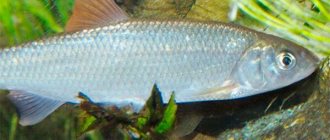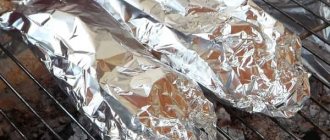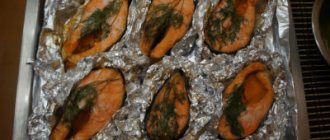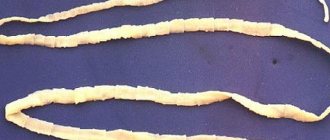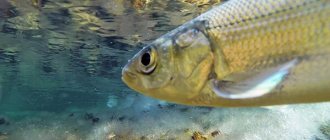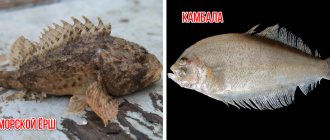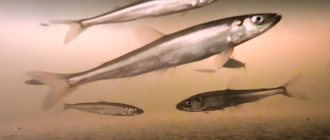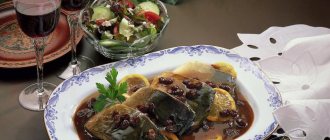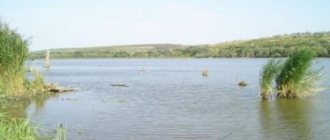Carp is one of the favorite trophies of experienced fishermen. Carp fishing is a special event for which you carefully prepare. In this article I will tell you about the characteristics of this fish, methods of fishing and cooking recipes.
Carp belongs to the carp family, a class of ray-finned fish. This is a large fish with a massive, rounded body. The head is proportional, large with bulging eyes. The powerful mouth is located at the bottom of the head, the upper jaw has a pair of pronounced antennae that are highly sensitive. The nostrils are double and located on top.
The scales are large, smooth, and fit tightly to the skin. The edges of the scales have a dark edging. Some varieties of carp, as a result of selection, have lost their scales or they have turned into skin (naked or leathery carp). The color of the scales largely depends on the type of fish and its habitat.
The body of the carp is covered with abundant mucus.
It performs several functions at once:
- improves gliding in the water column;
- regulates heat exchange;
- protects fish from infections and parasites.
Thanks to the mucus, carp are not so easy to grab with bare hands. Even after death, the scales continue to secrete mucus for some time.
Carps are long-lived. They calmly live up to 45-50 years, and at the same time reach gigantic sizes.
Types of carp
There is a misconception that carp fish is an artificially bred species, the ancestor of which is the carp.
This belief is completely wrong. In fact, carp have always been found in freshwater bodies of water. Those types of carp that lived in running water had a thinner, elongated body. The lake species, living in stagnant bodies of water with a rich food supply, gradually gained weight and increased in size. It was this species that began to be bred in the imperial ponds of China, from where it spread throughout Eurasia. Currently, carps are considered large freshwater fish that live mainly in stagnant water.
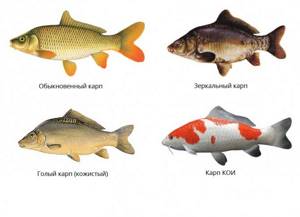
There are several varieties of carp:
- Common carp . The species is the most common. It is also called scaly carp, golden carp, etc. The body is massive, round, completely covered with scales. The color is closer to golden or brown; darker specimens are also found. It is this variety that is basic for cultivation under artificial conditions.
- Mirror carp . An exclusively selective species, bred in Germany in the century before last. One of the largest species. The scales do not cover the entire body, but only the upper part or are located along the central line of the body. The scales are very large, shiny, similar to small mirrors (hence the origin of the name).
- Naked (leatherback) carp . The name speaks for itself. There are practically no scales on the body of this type of carp. This species is not as common as others due to its increased vulnerability to infections and parasites.
- Wild carp . This species is found exclusively in natural conditions. It lives in reservoirs only with running water, since it cannot exist in conditions of oxygen starvation. The body of wild carp is highly elongated and covered with mucus. The structure of the muzzle has some similarities with the common carp.
- Koi carp (Japanese carp) . The Japanese are famous for their love of breeding ornamental fish. As a result of selection, they managed to obtain a stable species of carp with exotic colors. These are spotted fish with red and white colors. Morphological characteristics are similar to wild or common carp.
There are even rarer varieties of the carp family: Siamese carp, crucian carp, Chinese crucian carp. All these are hybrid forms.
Meals in one sitting (POP).
As the body fills with food, the carp requires more and more oxygen. During the summer, when the oxygen level in the water is relatively low, it is difficult for carp to get enough of it in one sitting (so-called one-sitting feeding).
It is best to consider this issue using the example of naked carp. The genetic differences between the naked carp and its counterparts (scaly, mirror and linear) determine the fact that it requires more oxygen during feeding (due to the smaller number of red blood cells). When the percentage of oxygen in the water decreases, naked carp are physically unable to take in as much food in one sitting as other species can consume, resulting in limited growth potential. When POP becomes unavailable during the summer months, all varieties of carp switch to a different feeding mode: little and often.
In winter, on the contrary, a high level of oxygen in the water improves the possibility of carrying out POP. This reduces the chances of repeated bites during the colder months of the year.
Carp size
The size of the carp largely depends on the variety. Wild carp do not grow to gigantic sizes. The average weight of individuals is 3-4 kilograms, but carp fishing is unpredictable; there have also been single specimens weighing up to 10 kg.
Lake species are much larger. Average weight 3-7 kg. But there are documented cases of catching common lake carp weighing more than 55 kg. The common scaly carp is slightly larger than the mirror carp. Japanese varieties do not grow to large sizes. Average weight 1-2 kg.
Lifestyle Features
Despite its impressive size, carp requires special conditions of detention. And only then will the fish grow and multiply quickly.
Habitats
Carp loves warm water, so it chooses mainly practically stagnant bodies of water: lakes, ponds, rivers with a small current and depth. This is an ideal place to live.
Also, carp does not tolerate direct sunlight, so the reservoir should be quite shady; a river with a forest along its banks is ideal.
Carps can be found from northern Russia to Asia. This fish will live wherever there are suitable conditions.
Carps have also chosen the warm shores of the Kingdom of Thailand. There are individual species here that are distinguished by their outstanding size and color.
The warm and humid climate is ideal for fish to live and actively reproduce. But these giants are found only in fresh water. And there are very few such reservoirs in the sunny country.
Nutrition
If carp is raised in a special private pond, it eats food that is provided to it by humans. However, if it grows in natural conditions, then it chooses a varied menu for itself.
It digests plants well and can feast on insects that find themselves on the surface of the water.
Carp is very fond of worms and mollusks that live on the bottom. In Asian countries they will not refuse shrimp, mussels, and larvae.
Predator or not
Carp cannot be called a predator, since it does not feed on other fish, much less humans. However, it is quite difficult to exist with him in the same area.
Some subspecies behave quite quietly and withdrawn. Others, more active, can organize real battles for territory, so individual inhabitants of the reservoir can be seriously harmed.
How long does he live?
The lifespan of carp depends on the conditions of detention. If all the necessary conditions are created in a private pond, she will live well for up to 20 years.
In their natural environment in warm ponds, some species can live up to 50 years.
Does pike eat carp?
Pike is a predatory fish, dangerous to many inhabitants of fresh water bodies. However, even this predator is unable to cope with an adult carp, which is of impressive size, so the pike prefers not to compete with such a giant and avoids it.
However, this predator can be dangerous for small carp under the age of two years. In size, they are exactly like perch, which pike can easily profit from, so it is better for the fry to stay in a school protected by larger individuals.
How does one gain weight?
Carp begin to rapidly gain weight at the age of 2 years. As a rule, in the natural environment everything happens simply. With age, the carp's body increases in size and the need for more protein appears. It can be easily replenished with the help of mollusks, worms, and larvae.
If we are talking about carp that are raised in private ponds, their weight can be artificially adjusted by humans. To do this, carp are offered food that is rich in protein. They start giving it at 6 months.
Carp quickly gain weight and can reach 5 kg in a year.
Reproduction and spawning
Like many other fish, carp are heterosexual. The reproductive organs mature by the first year of life, and maturity occurs by one and a half years. From the age of 2 years, the fish goes to spawn.
Ideal conditions for reproduction are water temperatures of at least 18 degrees. In private ponds, carp are planted for spawning in special cells that were created for these needs.
Two males are allowed into one female to ensure fertilization occurs. The fish spend about 10 hours together, after which they are released. The fertilized female quickly moves to the pontoon and after some time begins to spawn. Males are called upon to protect their offspring from various factors.
Fertilization in carp is carried out externally. Fertilized eggs develop up to 5 days, depending on environmental conditions.
What is the difference between a female and a male
The female and male differ in body size. Females are much more impressive in size. Upon careful examination, the male and female can be distinguished from each other.
Some types of carp allow you to distinguish individuals due to the special color that is inherent in females or males.
Differences between the sexes can also manifest themselves in behavior. For example, at the time of spawning, females are more warlike. But when the eggs are laid and need to be protected, the males begin to be aggressive towards everything that comes close to the future offspring.
At what age does it begin to spawn?
Carp begin to spawn at the age of 3 years. From one year on, nothing prevents him from going to spawn. However, at this age, fertilization occurs extremely rarely.
Carp spawning
Carps reach sexual maturity quite late. Males are able to reproduce in the third year of their life, and females only by the age of five.
Carp spawning occurs late, in late May - early June. This is due to the fact that the water must warm up to a temperature of +18°C. If the spring turns out to be cool, then carp can spawn in mid-June.
For spawning, the female chooses shallow water, where the depth is no more than half a meter. During carp spawning, you can even notice the dorsal fins of large specimens scurrying around in shallow water.
Before spawning, the female acquires several “gentlemen” who accompany her everywhere. The spawning area should be overgrown with thick algae or grass, into which the carp eggs will be deposited. Spawning occurs over several days. Females lay eggs from sunset until the morning.
Koi carp
Koi carp live the longest of all carp on Earth. Japanese researchers have been following the story of a long-lived carp named Hanako for a very long time. After numerous experiments, it was discovered that the age of the carp reached 217 years. The researchers were stunned by the results they could not believe. Hanako died at the age of 227. During this time, he managed to go down in history as a true centenarian. To this day, many scientists remain amazed at how the carp managed to live for so many years in a small pond. What conditions does this breed of fish need for a long life at the bottom of a reservoir?
Carp habitats
Carp is widespread throughout Eurasia. The habitats of wild varieties of carp are only in running water, as they need a good oxygen balance.
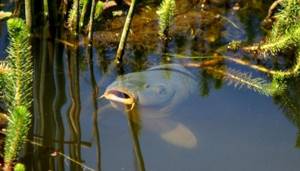
Lake varieties do well in standing water. These can be ponds, lakes, artificial reservoirs. Lake varieties are heat-loving, so they are not found in the northern regions.
The mirror and common species can live in fairly polluted, muddy water. This does not affect their health in any way.
In summer, carp prefer well-warmed areas with a depth of no more than 5 m. The bottom is chosen to be silty or clayey.
Where do carp live?
Carps live in almost all freshwater bodies of Europe, Asia, and North America. But since this fish is very thermophilic, it is not found in the north of Europe, Asia and America, but there are plenty of carp living in the temperate zone.
As habitats, these fish prefer large lakes and deep rivers with a slow flow and a moderately silted bottom.
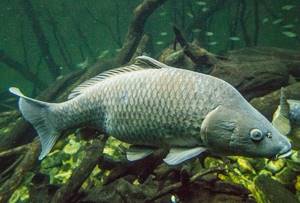
Carp lifestyle
Carp lead a gregarious lifestyle. Young animals gather in large flocks, and adults live solitarily, but still keep their relatives in sight. The young swim in shallow water, in thickets of algae. Large carp live in the depths, rising to the surface only in search of food.
Carps are sedentary inhabitants of water bodies and are not subject to migration. Their habitat is shadow and twilight. Sunny, clean clearings without algae are not for them.
Carp feeds in the morning and evening. Sometimes it can jump out of the water in search of food. He does this clumsily, leaving behind a lot of splashes and large circles on the water.
Carps are not aggressive. They never share territory, food or females. An important feature of this fish is the ability to see everything around and recognize colors.
In winter, carp are in suspended animation. They go deep, become covered with a thick layer of mucus and fall asleep. Awakening occurs only in spring, when the water temperature reaches 8-10 °C.
What to feed carp in a pond

Carp is a fish that is classified as omnivorous, since it eats almost everything that is in the body of its residence. Nevertheless, when deciding to breed this fish, you need to carefully approach the issues of its food; you should not hope that you will be able to get by with environmental products.
It is recommended to use the following feed options:
- A special combined food produced specifically for breeding carp and ensuring their proper growth. The composition of such food includes fish flour, special meal, wheat, and so on. Ordinary combined food, which is used when feeding chickens and other animals, can also be used, only when feeding carp it is important to dilute it with water until its consistency begins to resemble dough, otherwise the fish will not be able to cope with such food.
- Cereal grains and beans can also be used to feed this fish. But it is worth considering that it is not advisable to use them on a regular basis. It is best to feed after thoroughly soaking these grains. If beans or peas are used for feeding, they need to not only be soaked, but also steamed. If this is not done, the fish may acquire toxins, which promises a serious deterioration in the health of your pets in the near future.
- Protein food , which includes worms and other animals, may also be suitable. This feeding option contains all the necessary nutrients and perfectly saturates the carp. It is best to feed carp with this food in the spring and autumn. This food should be added all year round to avoid the development of unwanted diseases in the fish.
- Boiled potatoes. Potatoes should not be given raw to fish; this option can only harm it. It is also impossible to feed carp with potatoes alone, because the fish must receive all the necessary vitamins and nutrients. So it is better to use potatoes as a supplement to your main diet.
- Bread and cake can also be used, but not separately. It is best to give them along with grain crops. The cake can also be combined with boiled potatoes.
It is worth noting that this fish loves to eat insects. You can feed her with them, but it is worth considering that catching a sufficient number of insects will not be so easy. However, if you approach the issue correctly and try to drive the same, for example, mosquitoes into the light, you can quickly collect the required amount of food for carp. To do this, you just need to place the lamp above the water, after which the insects will fly into the light, and the carps, seeing that they are very close, close to the water, will eat them.
Life cycle of carp
After the female has laid eggs and the male has fertilized her, the countdown of the carp’s life cycle begins. After about a week, small larvae (no more than 5 mm) hatch from the eggs. For the first 10 days they feed on the yellow sac, which contains all the necessary nutrients. When the yellow sac disappears, the fry begin to feed on their own.
Juveniles live mainly in thickets of grass and algae. Carp grows very quickly, in a year it grows up to 20cm and weighs about 500g. By the age of two years, the carp already weighs more than a kilogram. By the age of 3, males become sexually mature, and females by five. The spawning period begins.
The lifespan of carp is on average 3-8 years. In remote places where there are no fishermen, carp can easily live up to 30 years or more.
Carp breeding
After the end of wintering, when the water warms up to 10 degrees, sexually mature 3-5 year old carp go to spawn, for which relatively shallow and overgrown areas are selected. Since there are not so many such areas, they are used many times, and each female is fertilized not by one, but by three to five males.
An interesting fact: the age of a carp is a necessary but not sufficient condition for its ability to reproduce; here, as they say, size also matters. So the body length of a male carp should be at least 29 cm, while the female should be even larger, at least 35 cm.
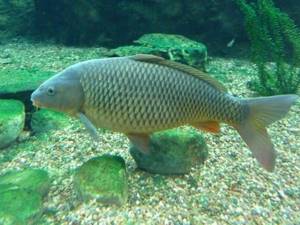
Carp fishing methods
Carp fishing methods are not an easy task, especially if the fish are large in size. The main rule is that the tackle must be strong and reliable to withstand the jerks of large fish.
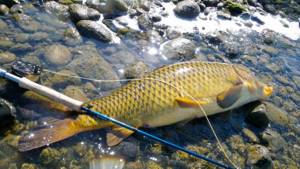
Recently, carp fishing with a feeder has become very popular. The device is simple:
- rigid rod (250-300cm);
- spinning reel;
- heavy feeder. She also plays the role of a sinker;
- leashes with hooks. They can be attached to a “yoke”;
- bite beacon.
You need to fill the feeder with bait (usually porridge or some kind of plant components). Using a fishing rod, the feeder along with the hooks is thrown into the pond. A bite alarm is installed on the fishing rod. That's it, you can rest and wait for the signal. Feeder feeders come in different sizes. The heavier it is, the further you can throw it.
Donka-zakidushka is probably the oldest and most proven method of catching carp. The simplest device is:
- reel;
- strong main line (the length depends on the specific body of water, but it is better to take it with a reserve);
- several leashes with hooks;
- heavy sinker (allows the hooks to stay in one place);
- bite beacon.
The fishing method is simple. A fishing line with a sinker and hooks is thrown onto the feeding area. You need to attach a bite alarm to the main line. This type of tackle can also be attached to a fishing rod with a tape measure.
The float rod is also popular when fishing for carp.
For it you will need the following gear:
- durable fishing rod (5-6 m). It is better not to skimp on it, since when nursing a large specimen, the flimsy tackle may simply break;
- reel with clutch;
- float;
- cut pellets for proper loading of the float;
- hooks;
- fishing line The main one should be thicker, the leashes should be thinner.
We attach the bait, throw the tackle into the feeding area and wait for a bite.
These were the three most popular ways to catch carp. Depending on the region, gear may have design features.
{banner_vnutri-kontenta-3}
Cooking methods
Fish can be fried in a frying pan or grill, baked in pieces, smoked, salted, and also cooked in a slow cooker or convection oven. Carp makes delicious shish kebab on the grill or barbecue.
How to bake in the oven?
It is more convenient to bake large carp cut into pieces, since in this case the meat is better cooked and soaked in spices, making the dish tastier. Small carcasses can be baked whole in foil.
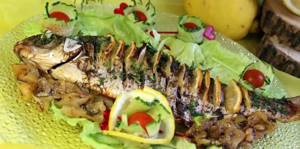
Entirely
In time, a whole carp carcass is baked in the oven for about 40 minutes at a temperature of 180 degrees.
Before cooking, the carcass must be cleaned and removed from fins and giblets, then rinsed under running water and blotted with a napkin to remove any remaining moisture. Next, marinate in spices with lemon juice.
Afterwards, you need to cover a baking sheet with foil, pour a little vegetable oil on top, put onion rings and carp on them. Close the foil tightly and place the baking sheet in the oven.
10 minutes before the end of cooking, the wrapper needs to be unrolled so that an appetizing crust forms on the surface of the fish.
Pieces
The fish cut into pieces should be baked in the oven at a temperature of 200 degrees on one side for 20 minutes, and then turned over to the other side and baked for another 10 minutes, reducing the temperature to 180 degrees.
Place the pieces on a baking sheet lined with parchment and greased with vegetable oil.
You can put onion, lemon or other vegetables on top.

How to fry in a frying pan?
Small fish can be fried whole, but large carp should initially be cut into pieces 2 cm thick.
In order for a delicious golden crust to form on the surface of the fish, the carp must be properly fried, namely, in a hot frying pan, without removing the skin from the carcass.
You can use flour or crackers as a breading. You need to fry the fish over medium heat, in well-heated vegetable oil, for 5-7 minutes on one side. If the pieces are large, then after a crust has also appeared on the back side, you need to cover the pan with a lid, reduce the heat to low and hold the fish for another 2 minutes.

How to stew in a slow cooker?
Peeled and cut into pieces carp should be salted, peppered, marinated for 10 minutes, and then placed in a multicooker bowl on a bed of onions, chopped and greased with vegetable oil. Sprinkle the top of the fish with chopped herbs and pour sour cream and water so that the carp is covered with liquid.
Cook on the “Stew” mode for 30 minutes. When the program completes its work, the dish can be served.
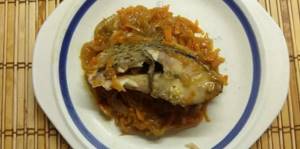
How to cook in the microwave?
Using the microwave, you can cook small carp stuffed with vegetables. To do this you need:
- clean the fish, remove fins and giblets, rinse and dry;
- make small cuts on the surface and rub the carcass with salt and pepper, leave for 10 minutes;
- fry chopped onion, grated carrots and garlic through a press in a frying pan, add salt and pepper;
- stuff the fish with filling (if desired, the belly can be secured with a toothpick);
- transfer the fish to a flat plate, the bottom of which is greased with vegetable oil;
- put the container in the microwave for 15 minutes, setting the power to 600 W;
- take out the fish, pour mayonnaise or sour cream on it;
- put in the microwave for 5 minutes at 450 W.
After the specified time has passed, you need to leave the carp for another 5 minutes in a closed microwave so that the fish finishes cooking, and then you can taste the delicious dish.

How to make it in an air fryer?
To cook carp in an air fryer you need:
- clean the fish, remove the head, fins and internal organs with black film, rinse the carcass and let it dry;
- Rub the carp with salt and pepper, sprinkle with lemon juice and leave for 15 minutes;
- coat the carcass with mayonnaise, put chopped white or red onion, pre-mixed with salt, in the middle;
- wrap the carp in foil;
- place in a convection oven;
- set the time to 40 minutes and temperature to 260 degrees.
If the fish is small in size, then trimming the head is not necessary.
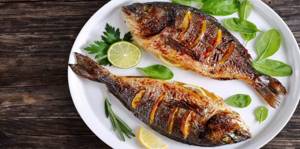
How to steam?
You can quickly cook a whole carp carcass in a double boiler, but it is recommended to marinate the fish first to make the meat more juicy.
Cooking steps:
- clean the fish, gut the abdominal cavity, trim the fins and head, rinse the carcass and wipe with a paper napkin;
- in a deep container, mix garlic, black pepper, ginger and coriander (to taste) passed through a press with soy sauce;
- place the carcass in the preparation, roll in the sauce;
- Cover the container with a lid and refrigerate for 1 hour;
- place the carp on foil, make sides, pour sauce over the top of the fish, and place in a steamer;
- Set the time to 25 minutes and cook with the lid closed.
After the time has passed, leave the fish untouched for 10 minutes so that it finishes cooking, and then you can serve the dish to the table.

How to cook?
Carp can be boiled whole or cut into pieces weighing up to 100 grams each (if the carcass is large).
To make the boiled meat tasty, it is recommended to soak the carp for half an hour in water with lemon juice before starting cooking, so that the smell of mud disappears from the fish.
How to cook carp correctly? The fish should be placed in cold water, after the liquid boils, you need to add bay leaf, salt and any spices to taste. A whole carcass weighing from 1 to 1.5 kg is cooked for 50-60 minutes. It is enough for the pieces to simmer for 15-20 minutes.
Uncleaned fish with giblets cannot be cooked, as the meat will be bitter and the broth will be cloudy. If you need to boil carp with its head, then you must remove the gills and eyes.

How to pickle?
To prepare 2 carps weighing 1 kg each, you will need 300 g of coarse sea salt, 6 bay leaves and peppercorns.
Salting stages:
- clean the fish, remove offal, black film, head, and fins;
- rinse the carcass thoroughly and dry;
- cut each carp into 2 equal parts;
- Pour half the salt into the bottom of a deep glass bowl, break 3 bay leaves and crumble the peppercorns;
- lay out the pieces of fish, press down firmly so that they are immersed in the salt;
- sprinkle the remaining salt and spices on top;
- cover with a plate, put on the press;
- Place the container in the refrigerator for 4 days.
After 4 days, you need to drain the resulting juice, remove the carp pieces and rinse under running water to get rid of excess salt.
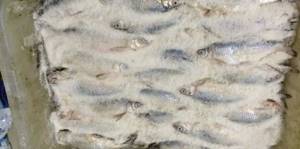
How to dry and wilt?
Small carcasses can be dried whole, but carp weighing more than 1 kg should be cut into 2 fillets before drying.
Cooking steps:
- clean the fish from scales and internal organs, remove fins and gills, rinse and wipe with a napkin;
- rub the carcasses with coarse sea salt outside and inside;
- prepare a warm salt solution, the volume of which depends on the amount of fish;
- put the carp in the solution, press it down with a lid, place a weight on top;
- after 2-3 days, drain the liquid and place the fish in the shade in a well-ventilated place for 30 days, turning it over periodically (if the carp is dried in the open air, then the carcasses should be covered with gauze).
To determine the correct consistency of the saline solution, you need to place a peeled raw potato or chicken egg in warm boiled water, and add salt gradually. When the selected product floats to the surface, the solution is ready.
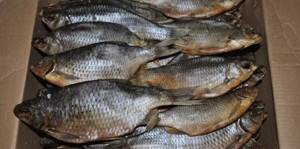
How to smoke?
Carp carcasses can be smoked either hot or cold. In the first case, the fish will be ready for consumption in a couple of hours, in the second - in a few days.
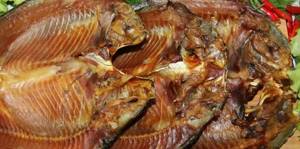
Hot way
Before you start smoking carp, the fish must be cleaned, giblets removed, gills removed and fins cut off. Then rub the carcass with oil with added spices and salt and leave to marinate for 4 hours.
Place alder chips on the bottom of the smokehouse and sprinkle with a small amount of water. Then place the carcasses on the grill so that there is a small distance between them. You can put onion rings and pieces of garlic on top of the fish for flavor. Smoke at a temperature of about +120 degrees for 1.5-2 hours. After opening the smokehouse, let the fish sit for another 15-20 minutes - and you can serve.
Cold way
To prepare carp cold, you will need fish, coarse salt and a smoker.
Smoking stages:
- clean the carp from scales, offal, black film on the walls of the stomach, fins and gills (large carcasses (more than 1.5 kg) are divided into 2 parts along the ridge);
- pour salt into a glass or plastic bowl, place the fish, pressing down so that they are immersed in salt crystals, also sprinkle coarse salt on top so that the carp is completely covered;
- cover the container with a lid and install the press, put in the refrigerator for 2 days;
- drain the released liquid, rinse the carcasses from salt, dry (inside and out);
- hang the carcasses outdoors for a day to dry a little (but not in direct sunlight!);
- transfer the fish to a smokehouse with alder chips and cook for 2 days in low heat (up to 30-45 degrees).
After the specified time has passed, you should open the smokehouse, but do not remove the carps so that the carcasses cool gradually.
How to cook on the grill?
Carp can be deliciously cooked on the grill using skewers or a grill. To do this you need:
- clean and gut the fish, remove the fins, head and black film from the belly walls, rinse;
- cut the carcasses into steaks of equal thickness, divide the pieces into 2 equal parts;
- marinate the fish in salt, pepper, lemon juice and tomato paste for half an hour;
- Carefully place the pieces on a skewer so that they do not sag anywhere, or place them in one layer on a wire rack;
- fry over coals over low heat for 7-10 minutes on each side.
Before serving the kebab, it is recommended to sprinkle the fish with lemon juice.
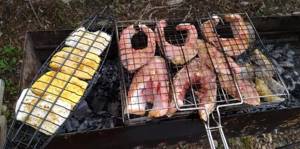
How to cook over a fire?
You can cook fish over a fire immediately after catching it. To do this you need:
- clean the carp from scales, remove the head and giblets, clean the abdominal cavity from the dark film, cut off the fins, wash the carcass;
- cut the fish into medium pieces, cut out the backbone, divide the pieces into 2 halves;
- rub the slices with salt, pepper and any spices that are nearby, leave for 15-30 minutes while the fire is lit;
- wait until the logs burn out and there is only a slight heat from the fire;
- place the fish on skewers and place over the fire;
- fry on each side for 7-10 minutes (until golden brown).
Serve with fresh vegetables, sprinkle with lemon juice if possible.
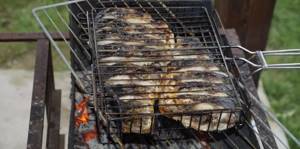
Carp baits
Carp baits are divided into three large groups:
- Plant origin. These include corn and peas, sometimes you can use large pearl barley. Flavored dough and bread have worked well.
- Animal origin. These are all kinds of worms, bloodworms, caterpillars, pieces of meat. As a rule, such bait is effective in mid-summer.
- Artificial origin. These are all kinds of flies, jigs, etc. Nowadays you can often find such baits in stores.
Many carp anglers make their own baits.
Description of the species
In fact, carp has long been a domesticated form of wild carp. But the carp has a much more elongated body. Many centuries ago, wild carp was domesticated in China. After this, travelers brought it to their countries. At first, it was used as a simple aquarium fish, but over time, this fish began to be bred on an industrial scale. This was facilitated by the fact that carp is very prolific and has gastronomic value. Carp were also released into wild bodies of water. Due to fertility, the population of the species in them quickly increased.
In addition, there was also natural migration of fish. Carp entered European waters through Asian rivers. The same caviar could have been transported from Asian regions to European waters by waterfowl. The carp also found its way to Australia, where the same situation developed with it as with rabbits. It quickly became the dominant species in Australia's global hydraulic system. Because of this, the issue of using the herpes virus to combat it is even being discussed. So in Australia it is easiest to catch a real trophy and this country is a kind of fishing Eldorado.
The carp has a moderately long body, which is covered with large scales. Most often, the sides have a golden or silver tint. The back is almost black. By the way, the color may change depending on the place where the fish lives. Pond species usually have a very dark color. But the river one differs from its pond counterpart in lighter colors. The carp's head is quite large. Its characteristic mustache allows it to be distinguished from other fish. It can also be easily distinguished from other fish thanks to its dorsal fin, which is quite long. The dorsal fin contains a spiny, jagged ray. There are situations when he cuts the fishing line with this beam.
Being an exclusively peaceful fish, carp prefers food of plant origin. It also feeds on a variety of worms, mollusks and insects. But it is unlikely that you will be able to catch it with fry.
Recommended reading: How to catch a loach
Baits for carp
The right bait for carp is half the success. The place should be well fed; there is no need to skimp on this.
Each fisherman has his own bait mixture recipes. I will tell you about the simplest and most effective ones.
Corn + pearl barley + cake + flavoring. Carp really like the smell of sour grains or legumes. Therefore, we prepare it this way: soak the corn and pearl barley in water for 12 hours. Then drain the water, add flavored oil and cake, mix. All the bait is ready. The recipe is simple, but no less effective.
Peas + cornmeal + flavoring. Peas need to be soaked for a day, and the water needs to be changed. When the peas are ready, mix them with corn flour and add flavoring.
The flavoring for carp also needs to be chosen correctly. Particularly attractive are: garlic, honey, caramel, vanilla.
Helpful information
Zoobenthos. As a basis for nutrition, carp ranks first in calorie content among natural foods. Zoobenthos includes small crustaceans, bloodworms, and worms.
Introduction of compound feed. A situation often occurs when juveniles refuse to feed. This happens because the fry are repelled by artificial food. To correct the situation, feed of the same type must be added before the carp spawn and thereafter. Thus, a gradual addiction to artificial additives occurs.
Compound feed. When purchasing mixtures, you should not save or rush. Be sure to study the composition of the granules. According to the study of A. Bogomolov (1995): “The use of unbalanced feed leads to a decrease in animal productivity by 50-60% or more.”
Features: It is better to feed fish in a home pond at the same time and in one place. In this way, all individuals will receive food and leftover food will not spoil, worsening the oxygen balance. For feeding, choose places free from vegetation.
Carp dishes
You can prepare a wide variety of carp dishes:
- baked carp - you can bake it in foil, on the grill, with vegetables, in various sauces. The carp will always be great. It’s not a shame to put such a dish on the holiday table;
- Ukha - you can prepare a rich soup from carp in the kitchen or in the field;
- cutlets - fish cutlets made from river fish - a healthy and dietary dish;
- fried carp - fried carp in a frying pan will not leave anyone indifferent. Tender meat with spices just melts in your mouth.

Cooking from carp is simple, even a novice housewife can handle it.
How fast does carp grow?
This “pig” has an incredibly fast growth rate, which is why it is extremely popular as a breeding target. At one year of age, the fish are 15 - 20 cm long and weigh 200 - 300 grams. By the third year of life, the body length reaches 30 - 45 cm with a weight of one to two kilograms. An eight-year-old carp weighs more than 6 kg. In general, it lives up to 50 years and grows to a length of more than one meter. The weight of the fish reaches 30 kg. However, specimens that are too large are not suitable for consumption due to their age. Their meat is tasteless.
Recommended reading: What do trout bite on?
How to breed carp?
Having prepared the reservoir and equipped it with the necessary equipment, you can start fishing directly. Step one is to decide on the type of carp.
It is recommended to take a species characteristic of the region where the fishery is being created.
Purchase of fry
It is safest to purchase fry from those who already successfully breed carp. At the same time, you can look at the life of a fish farm and make sure the fish are healthy. Before purchasing, you should familiarize yourself with the licenses and certificates of the seller.
An order for fry can be made from another region and delivered in a special way in tanks, buckets, or cans. They are filled either with water from a pond or rainwater.
When to put fish in a pond
The ideal period for launching fry into the water is the end of April - beginning of May. But the water should warm up to +22-24 degrees Celsius, which means artificial heating may be required.
Equipment for carp breeding
The minimum required for carp to live includes proper water and warmth. But there are devices that will make caring for fish easier and help increase the number of offspring:
- cages and cage lines;
- filters for water;
- aeration system;
- compressors;
- oximeter;
- oxygen generator;
- automatic fish feeders;
- barrels and pumps;
- water recycling system;
- incubators for hatching fry from eggs;
- bottom cleaners;
- sterilizers;
- instruments for testing water composition;
- backlight
Carp behavior after spawning
After the end of spawning, the carp gradually leaves the spawning grounds and takes up its usual habitats. At this time, he begins to actively feed, restoring strength after spawning. Usually the bite begins in May. At this time, it is caught using a float rod using grains of corn, peas, bread pellets, a worm and many other baits.
In deep areas it is better to use bottom fishing rods. Feeder gear will also perform well when fishing for scaly lumps
When summer comes into its own and the water warms up to the maximum, the intensity of the bite decreases. If water blooms are observed in a reservoir, then it may stop feeding altogether. On hot, sunny days, carp often stand at the very surface of the water. At this time, it is easy to detect with the help of polarized glasses. Polarized glasses differ from regular sunglasses in that they eliminate glare coming from the surface of the water. Thanks to this, the angler gets the opportunity to look several tens of centimeters deep into the water.
Recommended reading: Fishing for pike with a spinning rod in spring
If you find a carp standing at the surface of the water, you can try to catch it using a rig with a water ball. The water ball allows you to apply the nozzle on the surface itself. When fishing like this, it is best to use a regular crust of bread as bait. It is quite natural that if you add an attractant, the number of bites will increase. This fish loves fruity and sweet aromas.
With a gradual decrease in water temperature, carp become more active. In autumn there is generally a peak bite. At least until the water temperature dropped below 10 degrees. After reaching this mark, the pace of life of the fish begins to slowly decrease. This phenomenon is easy to explain. When the weather cools in autumn, fish sense the approach of winter. Of course, he is trying to prepare for winter as best as possible. This explains the strong surge in biting.
